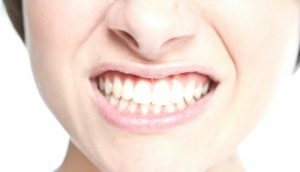 Pain in the gums is a very common phenomenon, but not many people know that they can be symptoms of serious diseases of the oral cavity.
Pain in the gums is a very common phenomenon, but not many people know that they can be symptoms of serious diseases of the oral cavity.
If discomfort persists for a long time, you need to visit the dentist and get detailed treatment advice.
Contents
- Pain syndrome in the gums - what is the reason?
- And aching and aching, you need a doctor Aibolit
- Toothpaste for gums
- Rinsing the mouth - also the method
- Gels that eliminate inflammation and pain
Pain syndrome in the gums - what's the reason?
Pain in the gums may differ depending on the causes that caused them. Often, soreness is associated with the development of diseases of the oral cavity, accompanied by an inflammatory process.
Among the most common dental problems, because of which the gums ache, there is a rather impressive list:
- Gingivitis .With the development of the disease, pain in the gums is localized in the area of tooth enfolding. There is swelling, severe redness, bleeding. The patient complains of soreness during the hygienic procedures, during the chewing process. Unpleasant sensations are of a periodic nature, associated with the impact on the teeth and, as a consequence, the gingival tissue.
- Stomatitis .Symptoms can appear after a negative effect on the mucosa against a background of reduced immunity. With stomatitis, the gum is sore and inflamed, but not throughout the entire oral cavity, but locally - in the lesions of the mucosa. Depending on the type of stomatitis, the inflamed area has a whitish bloom, a sore or a vial in the center. Pain in this place is caused by inflammation, manifested during the day with the slightest impact, for example, because of the ingress of air when opening the mouth.
- Periodontitis .The disease is localized in the tissues surrounding the root of the tooth. Inflammation begins when the infection through the root canal occurs during pulpitis or trauma to the tooth. Because of the accumulation of pathogenic flora under the gum, the latter becomes inflamed. In this case, the gum hurts over the tooth when pressed, if the latter is located on the upper jaw. The pains are permanent, pronounced in nature, and are dangerous by various complications: osteomyelitis, sepsis. It is not easy to remove pain even with anesthetics. As a result of a purulent process, the root canal cyst develops. At the initial stage, there is no pain, a person may even not notice the presence of a cyst. Also, it is possible to form a granuloma, which will cause pain, acute and locally localized.

- Periodontitis .With parodontitis, there is no obvious pain in the gums. The patient feels a burning sensation in the gums. At the initial stage they slightly swell, become loose, later depart from the teeth. Soreness is manifested when chewing or eating too cold, hot and acidic foods.
- Pericoronaritis .When the wisdom tooth erupts, the gum inflames strongly, swells. The process is accompanied by bleeding, with the gums hurting at the end of the lower or upper jaw, the pain is often blunt. Since the eruption process can take a few days and even weeks, the problem can make life very difficult. After a partial eruption of the wisdom tooth, often there is a gingival hood, which can also be a source of pain, but already due to the accumulation of pathogenic bacteria inside it.
-
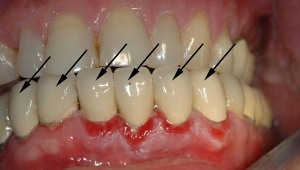
Injury of gums with crowns
Gum injuries .Pain in the gums may be caused by their trauma. Most often this happens when using a dental floss or too hard toothbrush. In this case, the gum hurts between the teeth. Incorrectly installed prostheses and crowns can mechanically affect the gums, resulting in the gum hurts under the tooth or near the tooth. The same applies to the chipped teeth.
- Tooth extraction .Pronounced aching pain occurs after tooth extraction. This is due to tissue damage. After a couple of days, unpleasant feelings should pass by themselves.
- of the scurvy .Lack of vitamin C adversely affects the microflora of the oral cavity and the condition of the blood vessels, which become permeable. As a result, the gums swell and bleed. A person complains about the excessive sensitivity of the periodontal tissues and even their soreness.
In addition to dental diseases, soreness of the gums may be caused by:
- immunodeficiency;
- incorrectly selected toothpaste;
- is irritated after dental procedures;
- infection of gum tissue;
- hormonal failures;
- by leukemia.
And aching and aching, it means that doctor Aybolit
is needed. And although the pain in the teeth is considered to be the strongest, the soreness of the gums is in no way inferior to it. Depending on the reasons that caused the problem with the tissues, it is necessary to select the medications that will kill the unpleasant sensations.
Only a dentist can do this, which will determine the stage of the disease, evaluate possible risks, prescribe the most effective course of treatment and anesthesia. Most strong pain medications have many restrictions and are sold by prescription.
 A visit to the dentist is mandatory if there is a suspicion of having one of the dental diseases. If the pain is permanent, then it is not worthwhile to delay the visit to the doctor.
A visit to the dentist is mandatory if there is a suspicion of having one of the dental diseases. If the pain is permanent, then it is not worthwhile to delay the visit to the doctor.
You can abstain from visiting a dental office after tooth extraction, if the pain has gone through a couple of days and there are no additional complications;with a minor injury to the gums, for example, with a stiff brush or dental floss;when teething, including wisdom, if it passes without complications.
Most of the pain reduction measures are restricted in the above cases, therefore only a doctor can prescribe the treatment.
What to do if the gums ache - the advice of an experienced dentist:
Toothpaste for the gums
To eliminate pain, inflammation and bleeding, you can use special toothpastes. They are good in that they have a direct effect on the symptoms, but their main drawback is that they do not cure the problem. This means that you will get rid of soreness, but after stopping the use of toothpaste for gums, the problem will resume.
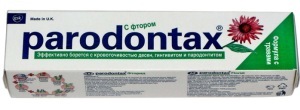 Most of the toothpastes of this type have active antiseptic substances and herbs, which reduce inflammation, kill microbes, and have a wound-healing property. Few of the pastes contain antibiotics.
Most of the toothpastes of this type have active antiseptic substances and herbs, which reduce inflammation, kill microbes, and have a wound-healing property. Few of the pastes contain antibiotics.
When choosing a hygiene product, it is recommended that you read the composition carefully and follow the indicated instructions, especially if there are restrictive factors.
If the pain when brushing teeth is severe, you need to replace the toothbrush. Soft bristles will reduce the effect on the gums, which will make the healing faster. After the course of treatment, it is recommended to return to the medium hardness brush again, as it copes with the bloom more effectively.
Among the most popular toothpastes for gums are:
- LACALUT aktiv and LACALUT fitoformula;
- Parodontax and Parodontax F;
- PresiDENT exclusive;
- Wood balsam from bleeding gums;
- Parodontol Active.
Rinsing the oral cavity is also the
method. What can I do to remove the pain in the gums and relieve their swelling? You can both rinse the oral cavity, and make lotions in the place of the source of pain.
The most famous remedy is Chlorhexidine, which is included in many toothpastes for gums. The solution has antiseptic, anti-inflammatory properties. Use it can be up to three times a day, rinsing the oral cavity after hygiene procedures for a minute.
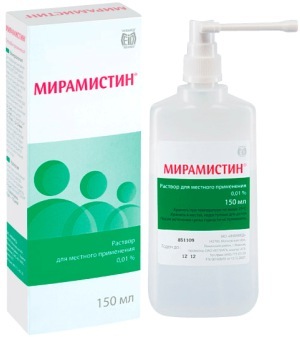 Miramistin is also considered a good remedy, although its effect is less pronounced. True, the solution has one advantage: it copes with the herpes virus, so it is prescribed for herpetic stomatitis or herpes localized in the oral cavity.
Miramistin is also considered a good remedy, although its effect is less pronounced. True, the solution has one advantage: it copes with the herpes virus, so it is prescribed for herpetic stomatitis or herpes localized in the oral cavity.
Hydrogen peroxide is a good antiseptic, but it is not recommended to apply it alone. Dentists use a means to clean the gum pockets during the procedures, but it is not suitable as the main drug.
An effective home remedy is a soda-salt solution with an antimicrobial effect. To make it, you need to add a spoonful of soda and salt in a glass of water. Rinse with such a tool the oral cavity can often, up to 10 times during the day. To strengthen the action of the solution and give it a wound-healing property, you can add a couple drops of iodine.
 Stomatophyte is a concentrated infusion of herbs that will help reduce pain in the gums. The course of fluid use lasts no more than 15 days.
Stomatophyte is a concentrated infusion of herbs that will help reduce pain in the gums. The course of fluid use lasts no more than 15 days.
Before rinsing it is necessary to dilute alcoholic infusion in the ratio 1: 5.Many use infusions and decoctions on medicinal herbs, relying on the advice of traditional medicine. Effective recipes, which include sage, eucalyptus, chamomile.
Gels that eliminate inflammation and pain
The most effective gel to eliminate pain and inflammation in the gums is Holisal gel. It has a wide range of actions, therefore it is very popular in the treatment of dental problems. The analogue of this drug is Mundizal-gel.
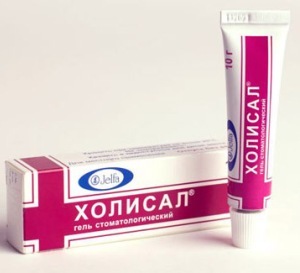 However, when teething, especially in children, preference should be given to other drugs with a narrow, but more aimed at eliminating unpleasant sensations action. When teething, as well as to relieve inflammation, can appoint Kamistad-gel, Kalgel, Dentagel. But their application should not exceed a week.
However, when teething, especially in children, preference should be given to other drugs with a narrow, but more aimed at eliminating unpleasant sensations action. When teething, as well as to relieve inflammation, can appoint Kamistad-gel, Kalgel, Dentagel. But their application should not exceed a week.
Metrogil Denta effectively cures pains in the gums, relieves inflammation. It contains an antibiotic, as well as Chlorhexidine. It is inferior to Holishal-gel, as it can not be absorbed into the gums, acting only on its surface.
This limits the range of use of the drug only to diseases of the oral mucosa. The analog of this drug is Asept's balm.
Pain in the gums may sometimes exceed the tooth, so it must be fought and preferably directed. Prior to a visit to the dentist, you can use drugs on the market that effectively cope with inflammation and harmful microflora, but only the doctor is able to prescribe a course of treatment to eliminate not only discomfort, but also their causes.
